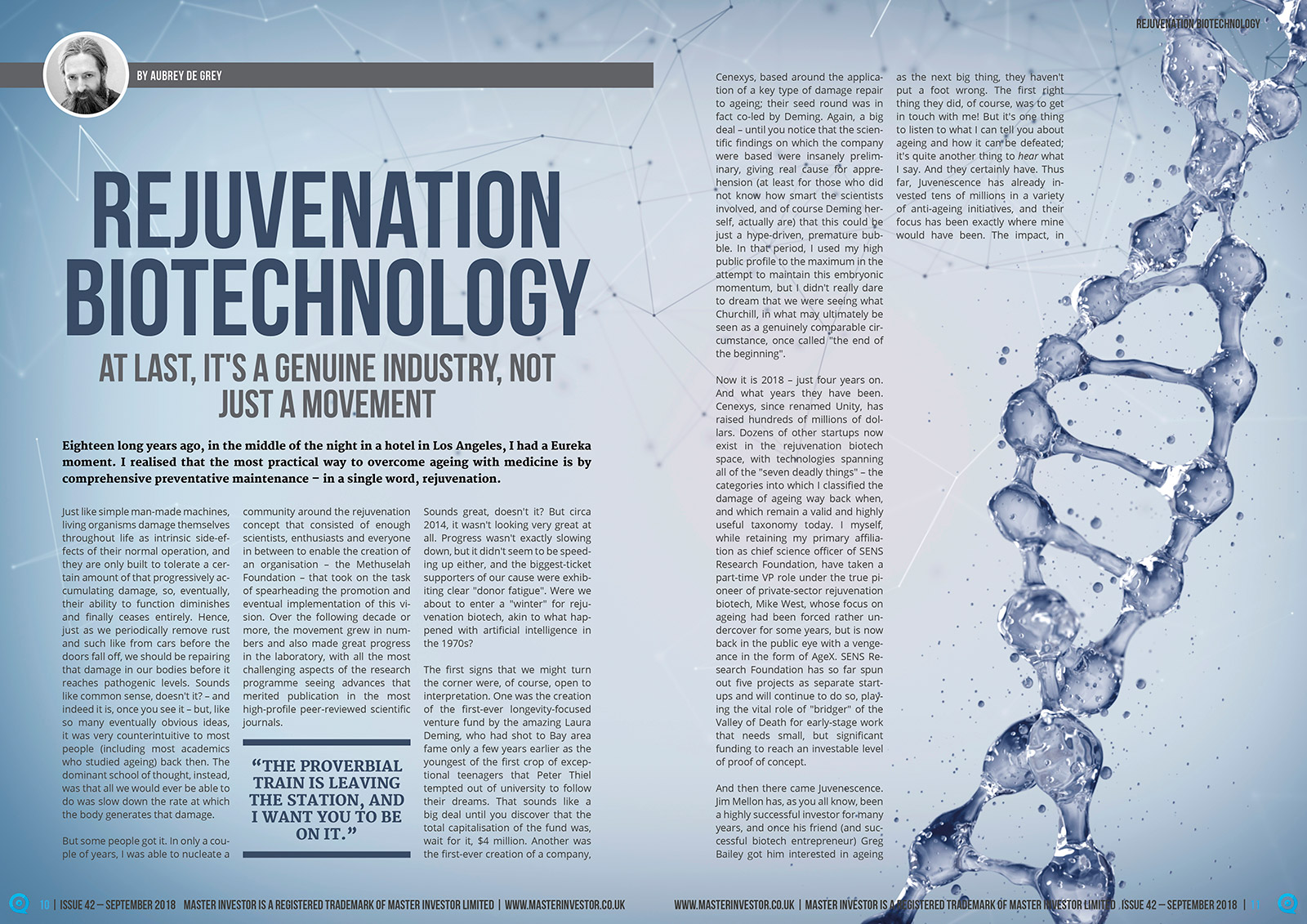Rejuvenation biotechnology: At last – it’s a genuine industry! – MAGAZINE EXCLUSIVEMAGAZINE EXCLUSIVE

MAGAZINE ARTICLE
This article first appeared in Issue 42 of Master Investor Magazine.
Click here to download the article as a printer-friendly PDF

Get this article and many more – for free! |
Eighteen long years ago, in the middle of the night in a hotel in Los Angeles, I had a Eureka moment. I realised that the most practical way to overcome ageing with medicine is by comprehensive preventative maintenance – in a single word, rejuvenation.
Just like simple man-made machines, living organisms damage themselves throughout life as intrinsic side-effects of their normal operation, and they are only built to tolerate a certain amount of that progressively accumulating damage, so, eventually, their ability to function diminishes and finally ceases entirely. Hence, just as we periodically remove rust and such like from cars before the doors fall off, we should be repairing that damage in our bodies before it reaches pathogenic levels.
Sounds like common sense, doesn’t it? – and indeed it is, once you see it – but, like so many eventually obvious ideas, it was very counterintuitive to most people (including most academics who studied ageing) back then. The dominant school of thought, instead, was that all we would ever be able to do was slow down the rate at which the body generates that damage.
But some people got it. In only a couple of years, I was able to nucleate a community around the rejuvenation concept that consisted of enough scientists, enthusiasts and everyone in between to enable the creation of an organisation– the Methuselah Foundation – that took on the task of spearheading the promotion and eventual implementation of this vision. Over the following decade or more, the movement grew in numbers and also made great progress in the laboratory, with all the most challenging aspects of the research programme seeing advances that merited publication in the most high-profile peer-reviewed scientific journals.
Turning the corner
Sounds great, doesn’t it? But circa 2014, it wasn’t looking very great at all. Progress wasn’t exactly slowing down, but it didn’t seem to be speeding up either, and the biggest-ticket supporters of our cause were exhibiting clear “donor fatigue”. Were we about to enter a “winter” for rejuvenation biotech, akin to what happened with artificial intelligence in the 1970s?
The first signs that we might turn the corner were, of course, open to interpretation. One was the creation of the first-ever longevity-focused venture fund by the amazing Laura Deming, who had shot to Bay area fame only a few years earlier as the youngest of the first crop of exceptional teenagers that Peter Thiel tempted out of university to follow their dreams. That sounds like a big deal until you discover that the total capitalisation of the fund was, wait for it, $4 million.
Another was the first-ever creation of a company, Cenexys, based around the application of a key type of damage repair to ageing; their seed round was in fact co-led by Deming. Again, a big deal – until you notice that the scientific findings on which the company were based were insanely preliminary, giving real cause for apprehension (at least for those who did not know how smart the scientists involved, and of course Deming herself, actually are) that this could be just a hype-driven, premature bubble. In that period, I used my high public profile to the maximum in the attempt to maintain this embryonic momentum, but I didn’t really dare to dream that we were seeing what Churchill, in what may ultimately be seen as a genuinely comparable circumstance, once called “the end of the beginning”.
| Meet Aubrey de Grey and other leading longevity experts at ‘Investing in the age of longevity’, our one-day masterclass on 1 November 2018 in London.
Extend your knowledge of the latest ageing related discoveries, and get the guidance and support you need to tap into some brilliant investment opportunities. Tickets are strictly limited and available on a first-come, first-served basis. Book early to avoid disappointment. |
Now it is 2018 – just four years on. And what years they have been. Cenexys, since renamed Unity, has raised hundreds of millions of dollars. Dozens of other startups now exist in the rejuvenation biotech space, with technologies spanning all of the “seven deadly things” – the categories into which I classified the damage of ageing way back when, and which remain a valid and highly useful taxonomy today.
I myself, while retaining my primary affiliation as chief science officer of SENS Research Foundation, have taken a part-time VP role under the true pioneer of private-sector rejuvenation biotech, Mike West, whose focus on ageing had been forced rather undercover for some years, but is now back in the public eye with a vengeance in the form of AgeX. SENS Research Foundation has so far spun out five projects as separate startups and will continue to do so, playing the vital role of “bridger” of the Valley of Death for early-stage work that needs small, but significant funding to reach an investable level of proof of concept.
Juvenescence
And then there came Juvenescence. Jim Mellon has, as you all know, been a highly successful investor for many years, and once his friend (and equally successful investor) Greg Bailey got him interested in ageing as the next big thing, they haven’t put a foot wrong. The first right thing they did, of course, was to get in touch with me! But it’s one thing to listen to what I can tell you about ageing and how it can be defeated; it’s quite another thing to hear what I say.
And they certainly have. Thus far, Juvenescence has already invested tens of millions in a variety of anti-ageing initiatives, and their focus has been exactly where mine would have been. The impact, in terms of hastening the date at which the damage repair paradigm will reach the level of comprehensiveness that can legitimately be called the defeat of ageing, will be huge.
And, of course, the money to be made will be huge too. In giving people a sense of what to expect, my simplest approach is to draw attention to today’s anti-ageing industry. Look at it – it is vast – depending on how you define it, it can be put in the hundreds of billions of dollars. And that’s for an industry based entirely on products that pretty much don’t work! It really doesn’t take much imagination to figure out how big an anti-ageing industry would be that was based on products that do work. And we, right now, are at the beginning of the process of turning that “would” into a “will”.
What does this mean for investors today? Well, for a start, you’re making a good first step by reading what Jim Mellon and his colleagues have to say; I believe that he contributes every bit as much to society by the advice he gives other investors, through outlets such as this, as he does by his own investments.
The train is leaving the station…
The other huge thing it means is that the faster a new industry grows, and the bigger it can be forecast to grow, the more merit there is in getting in early. Clearly, there are many considerations that determine a given investor’s choice of location on the risk/reward spectrum – but that spectrum is shifted in one industry relative to another, and the argument for being an angel or a seed investor in rejuvenation biotech may be stronger than in any other industry ever.
As a measure of this, I am gratified to note that most of the groundbreaking investors in this space, Jim included, are also making substantial, purely philanthropic donations to SENS Research Foundation. (In this regard I will particularly highlight the pioneering German web entrepreneur Michael Greve, who is donating the same amount that he is investing.) Why? Not only for philanthropic reasons, but because what you gain by donating is access to the research that we are still guiding across the valley of death, which is the key thing you need if you want the chance to be the founding investor (and the biggest ultimate winner) once we get it there. The earliest-stage work is the least expensive to perform, but without it there won’t be a next stage to invest in, and everyone, investors included, loses out.
In conclusion, let me offer the following personal perspective. As my appearance betrays, I am not a money guy – I am about as unmaterialistic as they come – so in order to spearhead this phase of the anti-ageing crusade I have surrounded myself with those to whom business comes naturally. But it takes two to tango; I would not have been able to do that if I had been delusional about the underlying technology, because I would have been found out.
Increasingly, month by month, more and more investors and businesspeople with the absolute highest level of credentials are making the decision that rejuvenation biotech really is the next big thing. Now is your chance to become one of them. The proverbial train is leaving the station, and I want you to be on it.
About Aubrey de Grey
Dr. Aubrey de Grey is a biomedical gerontologist based in Mountain View, California, USA, and is the Chief Science Officer of SENS Research Foundation, a California-based 501(c)(3) biomedical research charity that performs and funds laboratory research dedicated to combating the aging process. He is also VP of New Technology Discovery at AgeX Therapeutics, a biotechnology startup developing new therapies in the field of biomedical gerontology. In addition, he is Editor-in-Chief of Rejuvenation Research, the world’s highest-impact peer-reviewed journal focused on intervention in aging. He received his BA in computer science and Ph.D. in biology from the University of Cambridge. His research interests encompass the characterisation of all the types of self-inflicted cellular and molecular damage that constitute mammalian aging and the design of interventions to repair and/or obviate that damage. Dr. de Grey is a Fellow of both the Gerontological Society of America and the American Aging Association, and sits on the editorial and scientific advisory boards of numerous journals and organisations. He is a highly sought-after speaker who gives 40-50 invited talks per year at scientific conferences, universities, companies in areas ranging from pharma to life insurance, and to the public.

|
Comments (0)